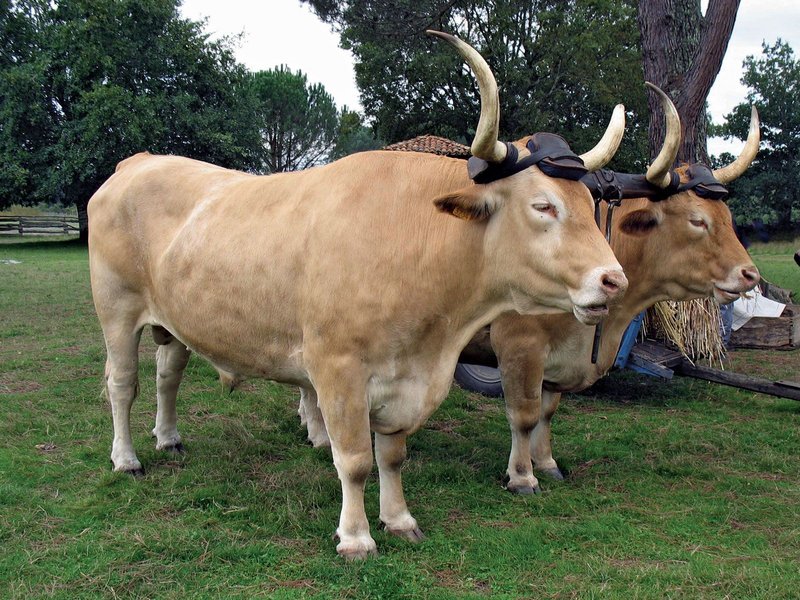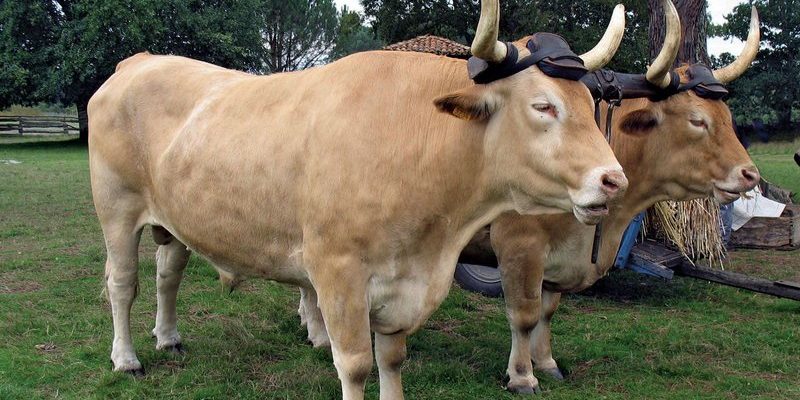
When you think of the term “ox,” what comes to mind? Perhaps a strong, lumbering animal plowing fields under the sun. Oxen are more than just that; they remind us of the intimate bond between humans and animals. These gentle giants have been our companions in agriculture for thousands of years, serving as reliable workers and symbols of strength. In this article, we’ll explore the fascinating world of oxen, their characteristics, history, and role in different cultures.
You might be surprised to learn that the term “ox” doesn’t refer to a specific breed but rather a type of cattle that’s been trained for work. This includes various breeds, traditionally male, which have been castrated to make them more docile. What makes them unique is their astonishing strength and endurance, making them perfectly suited for heavy labor. Think of them as the ultimate team players—working together with humans and each other to accomplish tasks that would be impossible for one alone.
Physical Characteristics
Oxen are generally large, muscular animals, characterized by their robust frames. They usually weigh between 1,000 to 2,200 pounds, depending on their breed and individual health. While most people picture them with a standard brown or black coat, oxen actually can come in various colors, including white, gray, and even brindle patterns. Their large heads, prominent horns, and strong legs give them an unmistakable presence in any field.
One interesting aspect of their anatomy is their muscle structure. Oxen have a powerful build, particularly in their neck and shoulders, which is essential for the heavy loads they often pull. You can think of their necks as ropes made of strong fiber, allowing them to generate significant force. Their sturdy feet are designed for stability and traction, which keeps them grounded while working on farms or in rugged terrains.
Table of Interesting Facts
| Size: | 4.5 to 6 feet at the shoulder |
| Weight: | 1,000 to 2,200 pounds |
| Diet: | Herbivorous; primarily grass, hay, and grains |
| Lifespan: | 10 to 15 years |
| Speed: | Up to 10 mph |
The Role of Oxen in Agriculture
Oxen have been integral to farming for centuries. Before tractors and modern machinery, farmers relied on oxen to plow fields, pull carts, and transport goods. They possess a natural ability to work in tandem, making them effective at sharing the workload. Imagine a team of oxen marching together, each one understanding its role in the task at hand. That’s teamwork in the animal kingdom!
These animals are particularly well-suited for tasks that require endurance rather than speed. They can work long hours without tiring, making them ideal for extended farming tasks. Farmers often cherish their oxen not just for their strength but also for their gentle demeanor. It’s not uncommon for farmers to form deep bonds with these animals, treating them as family members.
Cultural Significance of Oxen
Beyond the field, oxen hold a significant place in various cultures. In many parts of Asia, they are revered for their strength and hard work. The Chinese New Year celebrates the Year of the Ox, symbolizing diligence and perseverance. In India, oxen are often featured in religious rituals and festivals, embodying respect and reverence.
In historical contexts, oxen were also used as symbols of nobility. Kings and rulers often used decorated oxen in parades, showcasing the might and prosperity of their reign. With such a storied past, it’s clear that oxen are more than just farm animals; they represent a cultural legacy that spans the globe.
Oxen vs. Cows: Key Differences
While both oxen and cows belong to the same species, they are quite different in terms of roles and physical characteristics. The most significant difference is training and purpose. Oxen are typically castrated males trained for work, while cows are females primarily raised for milk and breeding.
Physically, oxen tend to be larger and more muscular than cows. Their strength and endurance make them ideal for carrying heavy loads, whereas cows are generally more suited for nurturing calves and producing milk. Think of it this way: oxen are like the bodybuilders of the cattle world, while cows take on the role of nurturing caregivers.
Care and Management of Oxen
Caring for oxen requires knowledge, patience, and dedication. A well-cared-for ox can live a long and healthy life, often yielding better performance in work tasks. Proper nutrition is crucial; oxen thrive on a balanced diet rich in fiber, which includes hay and pasture grass.
Regular health check-ups are essential to prevent illnesses that could hinder their work capabilities. Just like you would want to keep your pet healthy, ensuring your oxen are vaccinated and free from parasites is vital. Farmers typically develop a close relationship with their oxen, which helps in training and managing their behavior.
Training Oxen
Training oxen is an art that combines patience and consistency. Young oxen learn basic commands from their handlers, often starting with simple leash work. They need to be accustomed to the harness and yoke, which can sometimes take a little time. Imagine teaching a child to ride a bike; it’s a process that takes encouragement and practice.
As they grow older, oxen learn to work in teams and respond to commands from their handlers. Training sessions often involve short, focused practices to avoid overwhelming them. With time, oxen develop a bond of trust with their trainers, making them not just workers but companions as well.
Oxen in Modern Times
In today’s world, while modern farming equipment has minimized the need for oxen in many places, these animals still play an essential role in certain regions. In developing countries, oxen continue to be vital for agricultural work, helping farmers till the land and transport goods.
Moreover, oxen have found their niche in sustainable farming practices. Many organic farms prefer using oxen due to their minimal environmental impact compared to tractors. The slow and steady pace of oxen work helps maintain soil health and prevents soil erosion—a win-win for farmers and the environment.
Oxen in Popular Culture
Oxen have also left their mark in popular culture. From storybooks to movies, they often symbolize strength, hard work, and loyalty. Children’s stories frequently feature oxen as gentle giants, teaching lessons about perseverance and friendship. You might remember tales of hardworking animals helping humans achieve great feats, and oxen are usually at the helm of these stories.
In folk art, oxen are celebrated through various forms, from paintings to sculptures. They represent a connection to our agricultural roots and serve as a reminder of the vital roles animals play in our lives. This cultural representation keeps the legacy of oxen alive, reminding us of the simplicity and beauty of rural life.
Oxen are remarkable creatures that have significantly impacted human history and culture. Their strength, gentle nature, and ability to work alongside humans make them unique among livestock. As we look toward a future that increasingly values sustainability, oxen remind us of the deep-rooted ties we have with our environment and the animals that help sustain it.
FAQ
What are the primary uses of oxen today?
Today, oxen are primarily used for agricultural work, especially in developing countries where modern machinery may be scarce or too expensive. They are invaluable for plowing fields, transporting goods, and even participating in cultural festivals. There’s a growing movement advocating for sustainable farming methods, where oxen play a crucial role due to their minimal environmental impact.
How long do oxen typically live?
Oxen usually live between 10 to 15 years, although proper care can sometimes extend their lifespan. Factors such as diet, living conditions, and health care all contribute to their longevity. Farmers who build trusting relationships with their oxen often report healthier and happier animals, which can lead to a longer life.
Do oxen have special dietary needs?
Yes, oxen are herbivores with specific dietary requirements. They primarily consume grass, hay, and grains. A balanced diet is essential for their health and work performance. Additionally, oxen require ample water and must have access to minerals to maintain optimal health. Just like people, a well-rounded diet helps oxen thrive.
What breeds of oxen are commonly used?
Several breeds are commonly used as oxen, including the Brahman, Holstein, and Hereford. Each breed has unique characteristics, such as size, strength, and temperament, that make them suitable for working tasks. Farmers often choose a breed based on the specific tasks they need the oxen for, whether it’s plowing fields or pulling carts.
How do you train an ox to work?
Training an ox involves patience and consistency. It usually starts with basic leash work, teaching the ox to respond to commands. Older oxen learn to work in pairs or teams, and they must become comfortable with the harness and yoke. The key is to keep training sessions short but frequent, building trust and encouraging them to follow commands.
Are oxen considered pets?
While oxen are primarily working animals, many farmers form strong bonds with them, treating them as part of the family. This relationship fosters trust and cooperation, making them even more effective workers. In some cultures, oxen are seen as companions, enjoying care and affection like pets, especially when raised from a young age.
Can oxen be used in competitions?
Yes, oxen can participate in competitions, often seen in agricultural fairs and festivals. Events may include plowing contests, where teams of oxen are judged based on speed and precision. These competitions celebrate the skills of both the animals and their handlers, showcasing the traditional roles oxen have played in farming communities.
What is the difference between an ox and a bull?
The primary difference lies in their training and purpose. An ox is usually a castrated male trained for work, while a bull is an uncastrated male used primarily for breeding. Bulls are generally larger and more aggressive, while oxen tend to be gentler and more suited for farm tasks. Their roles in agriculture highlight the diverse ways humans interact with cattle.
Do oxen have any natural predators?
In the wild, adult oxen have few natural predators due to their size and strength. However, young oxen can fall prey to large predators like lions or wolves. In agricultural settings, their main threats come from disease or human-related hazards rather than predation. Proper management and care help minimize risks to their health.
How does climate affect oxen care?
Climate plays a significant role in oxen care. In warmer regions, oxen need shade and plenty of water to prevent heat stress. Conversely, in colder climates, they require shelter to protect them from harsh weather. Farmers must adapt their care practices based on the local climate to ensure their oxen remain healthy and productive.

